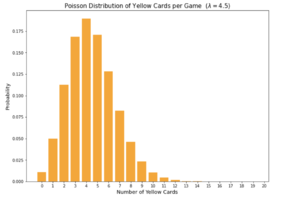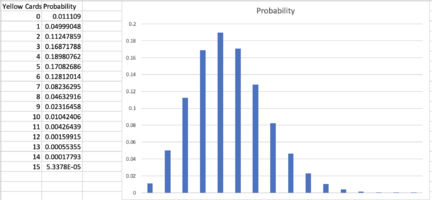Hello guys, I am a newbie here and I desperately need to answer this question which kind of blows my mind.
We have a normal football match and based on data we want to predict the probability of how many yellow cards we will see.
There have been 10 games played and team A got in average 4 yellow cards in a match, team B got in average 5 yellow cards in a match.
Solely based on above mentioned date we know that the average number of cards in this match should be 4.5. Now we want to to know, what is probability of each scenario based on above mention. What is probability of 0 yellow cards, 1 yellow card, 2 yellow cards and so on. Theoretically there can be up to 32 yellow cards in a football match (22 players in a line-up and up to 10 subtitutes).
If I'm not mistaken, given that the average of yellow cards in a given match will be 4.5, there should be a 50% chance that 4.5 cards will fall, which is not possible, so 25% that 4 will fall and 25% that 5 will fall? If so, how do I calculate the other odds. The chance that 0 yellow cards will fall is not great, but there is, however the chance that e.g. 15 yellow cards will fall is almost zero, as well as the highest possible number 32.
Is there any easy solution to this math problem?
We have a normal football match and based on data we want to predict the probability of how many yellow cards we will see.
There have been 10 games played and team A got in average 4 yellow cards in a match, team B got in average 5 yellow cards in a match.
Solely based on above mentioned date we know that the average number of cards in this match should be 4.5. Now we want to to know, what is probability of each scenario based on above mention. What is probability of 0 yellow cards, 1 yellow card, 2 yellow cards and so on. Theoretically there can be up to 32 yellow cards in a football match (22 players in a line-up and up to 10 subtitutes).
If I'm not mistaken, given that the average of yellow cards in a given match will be 4.5, there should be a 50% chance that 4.5 cards will fall, which is not possible, so 25% that 4 will fall and 25% that 5 will fall? If so, how do I calculate the other odds. The chance that 0 yellow cards will fall is not great, but there is, however the chance that e.g. 15 yellow cards will fall is almost zero, as well as the highest possible number 32.
Is there any easy solution to this math problem?


